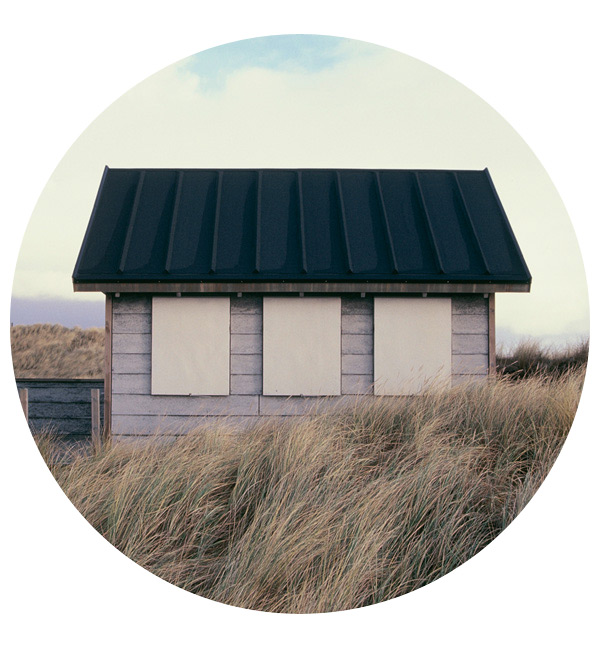
"Ganz Gut – Quite Good houses" has positioned itself alongside those architecture books that show us who has built what, when, and where, theoretical papers on the subject and aesthetic photo books. Even upon first glance, it is clear that this book by Berlin architect Oda Pälmke is much more than its title suggests. The front cover shows a circular segment of a photograph with a house at its centre, the rest pure-white as though it has been blocked out. It is certainly a meticulously formed, beautifully-bound book in small format that you have in your hands here. Upon first perusal, we come across pictures of housed that somehow seem familiar to us. We find ourselves reminded of places that we have seen before, on the streets that we may have once walked along. We are transported to the small town, the village or the seaside. For in "Ganz Gut – Quite Good houses" Oda Pälmke takes us on a very special journey. And so, we set off in "search of the beauty of the incidental". From our place in the passenger seat we encounter those kinds of houses that we just can't help but laugh at, houses that make us sad for no reason, or put us in a bad mood. "Quite good" means: somehow not so bad, there's something interesting about it, I might even like it. Consequently, "Ganz gut" is more than a highly subjective collection of simple, wayside houses that were not necessarily "created" but rather "came into being", it is also a roadbook. Our interest is directed at the exceptional exemplars among these simple buildings, those small houses that nonetheless have great effect in the motifs encoded in their visual image. Here Pälmke stresses the importance of these peculiar little objects, which after the first fleeting glance have now been given a second chance as the subjects of an affectionate and at the same time analytical consideration. The "house with a rather grim countenance" and the "house with an enchanting aura" now stand side by side, as do the "house with the moustache" and the "house with the mutton chops". As couples, chance acquaintances or the result of a long search for the right counterpart, they reveal the affinity they have with one another and at second glance they disclose their differences and peculiarities too. It is that special something about these houses that lures us into speculations about their history, the preferences of their owners or what kind of people live inside. You almost get the feeling that you know exactly who is going to open the door. The architect demonstrates the unique qualities of these architectural interventions in the foreword – and at the very latest by the time we reach the end of the book, when each and every house has been given a name, we are able to recognize the fine line between the "sad little house" and the "sad little spruced-up house". By then we have also learnt that while one carefully bricked-up window can become a decorative element, another becomes more of a riddle. Whether that simple fire-resistant wall covered in sheet metal, classically divided up into base, mid-section and attic, takes on a new grandeur or to the contrary takes on an even more dismal look; whether extensions, windows and doors have a positive effect on the house's appearance or rather create a woeful end to the story, is dependant on the point of view of the reader. Furthermore, the inspiring, often astounding and extremely humorous remarks invite the reader to discover exactly what it is that – beyond architectonic concepts and theories – anchors such simple buildings so steadfastly in our memories. In this respect this, the author's second book, is a continuance of the typological series, published by the same publishing house in 2008 entitled "Types – Good, Bad and Ugly Houses". Architecture students from Dortmund's Technical University were entrusted with the task of creating sculptural molds depicting their perception of a "house", reduced to its most important characteristics. Poured into concrete casts, they produced "types", which not all that surprisingly evidenced a close relation to the houses in this new volume. The search for this kind of quality, which must originate in a space beyond architectural trends, between the often idealized notion and the hard reality, remains an exciting architectonical challenge. In particular today, in a period where there exists a rapidly-expanding divide between everyday architecture, which is predominantly determined by economic factors and thus lacking in creative ambition and often in input of expert architects too, and magnificent one-off architectural artworks. Jim Jarmusch once said: "We tend to underestimate the little things in life. It is art's task to recognize and appreciate their true significance." Oda Pälmke gives a face to these everyday objects. She photographs small houses that are undervalued and has us see them through her eyes. Her color photographs are seemingly casual snapshots, which still succeed in inspiring us to question and contemplate. "Ganz gut – Quite Good Houses" is a small book that consciously uses the simplest means possible to demonstrate a kind of architecture that may not seem so spectacular – but in its own special way really is. Ganz gut – Quite Good Houses
Published by Oda Pälmke
Hardback, 176 pages, German/English
Jovis, Berlin, 2012
Euro 20.00
www.jovis.de









